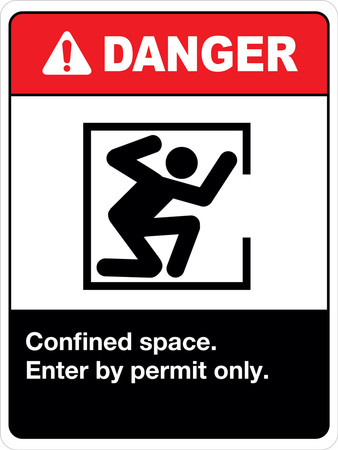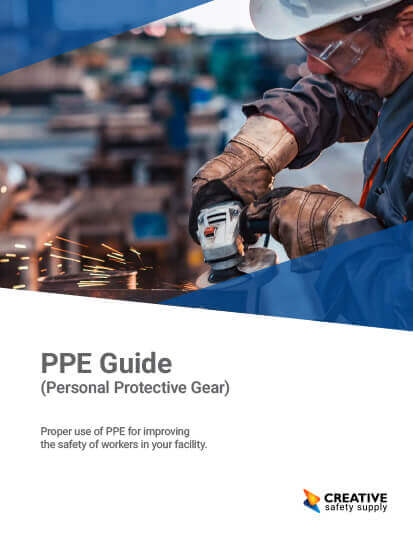
- What is a Confined Space?
- Hazards of a Confined Space
- What is a Confined Space Entry Permit?
- Confined Space Permit Requirements
- Confined Space Safety Signs
- Confined Space Training for Employees
- Clearly Identify Potential Exits
- Safety Partner
- Personal Protective Equipment
- Other Equipment for Confined Spaces
- Taking Confined Space Safety Seriously
Understanding confined space hazards is essential for workplaces that have these types of areas on site. Even if employees aren’t tasked with jobs that require their presence in these spaces often, they need to know how to keep themselves and others safe, as well as stay OSHA compliant. When trained properly, confined space safety efforts can minimize risks for those who are required to enter these areas.

What is a Confined Space?
Confined spaces are areas that weren't designed for regular human occupancy due to size, restricted means of entry and exit, and a hazardous atmosphere. In many cases, a confined space also has the potential to cause someone to get stuck or run into a variety of other safety and health hazards such as a lack of oxygen or a risk of asphyxiation.To get a better grasp of the vast characteristics of confined spaces, the following is a list of common places that are classified as such:
- Tanks, Vessels, and Storage Bins – These can be considered confined because there is only one way in or out during cleaning operations.
- Silos – Silos are very large, but people often fail to think about them when discussing confined spaces. There is limited room, limited exits, and the ability to become trapped or buried.
- Vaults – Whether a bank vault or a storage vault, these are often large enough to walk in and move around, but still quite cramped.
- Pits – This is another often-overlooked example. If someone falls into a pit, they may have quite a bit of room to move around. Despite this, however, they are still stuck in one area.
- Manholes and Tunnels – Both of these typically only have one entry/exit, are very tight spaces, and have the additional possibility of having a hazardous atmosphere.
- Ductwork – Large facilities have ductwork big enough for people to fit inside, which may be required for cleaning or other maintenance work.
- Pipelines – Pipes are very similar to ducts; except they transport liquid or gas.
Hazards of a Confined Space

Around 2.1 million workers enter confined spaces to perform work-related tasks every year. Out of those 2 million, there are about 100 who never return home, 60% of those deaths being employees who attempted to rescue already trapped victims.
Entering a confined area needs to be done very intentionally to avoid problems. For example, employees who need to enter large pipes should understand that their body could cut off the light and their air supply, so they need to bring an SCBA for respiratory protection and a flashlight. The following are additional examples of existing health and safety hazards within confined spaces:
- A Lack of Oxygen – As oxygen depletes, people can become lightheaded and even pass out, which could lead to injuries or even death.
- No Ventilation – Since there is typically a lack of effective ventilation in confined spaces, it’s easy for otherwise harmless gasses to build up. Even small amounts of gas that would normally just dissipate into the surrounding area can become deadly.
- Becoming Trapped –Most confined spaces only have one entry and exit point. If that becomes blocked or otherwise unavailable, the employees can become trapped.
- Fires or Explosions – Smoke can build up very quickly and explosions can cause the area to become unstable.
- Smothering –In tunnels or other similar areas the roof can cave in, smothering people. In other situations, things like grain in silos can engulf a person and suffocate them.
- Instability – In many confined storage areas, product shelving can become unstable. Employees in the area won't have anywhere to flee should they begin falling.
- Electrical Hazards –One of the most common reasons for entering a confined space is to work on electrical equipment. If there isn't much room, employees may be at greater risk of experiencing something such as an arc flash.
What is a Confined Space Entry Permit?
In many cases it’s up to the employer to decide when confined space entry is necessary. In others, however, there are federal regulations in place that require a permit to enter confined spaces. This rule is 29 CFR1910.146, and is very important for employers to be aware of before having anyone work in a confined area.
OSHA defines a confined space as one that has limited entry/exit, is large enough for a person to enter and perform work but isn't designed for continuous occupancy. A permit-required confined space has all of the characteristics of a confined space, plus an additional hazard such as:
- A hazardous atmosphere
- A material that can engulf someone
- Unguarded machinery or wires
- Floors and walls that taper in a way that could trap a person
When in doubt, it is best to contact OSHA directly to have them help determine when a permit is required and when it’s not. Depending on the situation, they can either evaluate a confined space over the phone or send out an inspector to help look at the area and decide.
Another great option is to use the OSHA Confined Spaces Advisor. This is an online tool that goes through several questions. Based on the answers to these questions, OSHA will make recommendations on whether or not the area is classified as a permit space.
Confined Space Permit Requirements
When it has been determined that a permit is required for a confined space, the employer has several requirements to follow for ensuring the safety of their employees. Just to be clear, these best practices are also excellent to follow even if the confined space being entered is a non-permit area.
Confined Space Safety Signs

First, the confined area should be clearly identified with a safety sign. This can be done using a sign on a post or on a doorway. The safety sign should clearly identify an area as a confined space and let people know not to enter without first getting the proper permits and permissions.
Confined Space Training for Employees
As with just about all workplace safety efforts, being safe in a confined area starts with proper training. All employees who work in or around confined areas must go through a formal training program provided by their employer. In many cases, these training programs need to be approved by OSHA in order to get the necessary permits. Regularly taking safety classes and taking opportunities for refresher training are also excellent.
Even in areas that aren't legally defined as confined spaces providing training to anyone who works in smaller environments due to the elevated risks is still recommended. Most companies that provide this type of training do it as part of their new employee orientation process, and then also invite seasoned employees to take the training if they are changing jobs or need a refresher.
Clearly Identify Potential Exits
The potential exits of a confined space should be clearly marked so the employees can see them. These exits should be marked with something that can be seen easily, even if the area became dark or smoky. Having the ability to exit a confined space quickly is one of the most important ways to stay safe.
Safety Partner
Anyone entering a confined space should have a partner who remains outside of the confined space, but in constant visual and auditory contact. Should something go wrong, the person outside of the confined space can quickly call for help. It’s important to note that the person outside the confined space should not enter to provide assistance unless there is someone else there with them who can stay on the outside to seek additional assistance.
Personal Protective Equipment
Personal protective equipment is extremely important when working in a confined space. Just like under normal working conditions, the specific types of PPE required will vary from location to location. Hard hats, protective gloves, shock-resistant clothing, facemasks, eye goggles, hearing protection, and more may be required to keep employees safe.
Employers are legally required to provide the necessary PPE for employees working in confined spaces. All PPE should be kept in an area near the entrance to a confined space, and signs should be put up letting employees know that they cannot enter without first putting on the required PPE.
Other Equipment for Confined Spaces

- An Air Supply - While it does not apply to every situation, in confined spaces, oxygen levels can be depleted quickly.
- Light Source - Having a personal light source like a flashlight is very important. If the lights become damaged or otherwise go out in a confined space, having the ability to illuminate the area can help ensure the employee's safety.
Investing in the right type of equipment for working in an enclosed area is critical for the safety and health of employees, as well as for remaining in compliance with OSHA regulations.
Taking Confined Space Safety Seriously
One of the biggest problems with confined space safety programs is that many employees and even employers don't take them seriously. While everyone knows there is a potential for danger in a confined space, people become overconfident that an accident won't happen to them. Employers and employees need to realize that the safety and health hazards listed above can happen to anyone at any time.Similar Articles
- Arc Flash and Electrical Safety
- Arc Flash PPE
- Hierarchy of Controls [Hazard Exposure + Prevention]
- Hazardous Waste Disposal
- Mine Safety & Health [Expert Advice]
- 10 Essential Steps for Electrical Safety
- Fire Prevention in the Workplace [OSHA 1910.39]
- Anhydrous Ammonia – Safety & Labeling
- Typical Lockout Tagout Procedures


